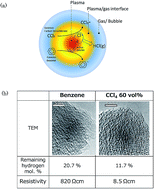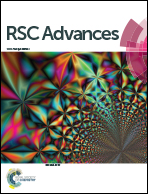Enhancement of conductivity in nano carbon balls by the addition of carbon tetrachloride via room temperature solution plasma process
Abstract
The conductivity of carbon nanoballs (CNBs) was enhanced by two orders of magnitude with the addition of carbon tetrachloride through a room temperature solution plasma process without post-heat treatment. The synthesized CNBs demonstrated the lowest resistivity of 8 Ω cm when the ratio of benzene to carbon tetrachloride was adjusted to 3 : 2. The morphologies from Transmission Electron Microscopy (TEM) showed the benzene-synthesized CNBs appeared as amorphous carbon while CNBs generated from the mixture of carbon tetrachloride and benzene were presented as short range graphite with turbostratic structure. From Raman spectroscopy and X-ray diffraction patterns, the results indicated the transition from amorphous carbon to nanocrystalline-graphite (NCG). From chemical elemental analysis, the hydrogen mole percentage decreased 20–50% when 20–60 vol% of carbon tetrachloride was added into benzene. We expect that this approach can be extended to enhance the conductivity of all kinds of amorphous carbonaceous materials in other synthesis technologies under room temperature.


 Please wait while we load your content...
Please wait while we load your content...